Exploring the Physical Environments of Canada in Google Earth
Objective:the purpose of this assignment is for you to explore some interesting physical features ofCanada using Google Earth, to gain facility using this tool, and to gain facility in simple editing of images.
In Google Earth, under Primary Database, make sure you have Borders and Labels ticked (but, be warned, sometimes the only way you can find out the name of a place is by looking at the photo captions).
You can save images in Google Earth under File, Save, Save Image or you can simply copy the image under Edit.
You can use a simple picture editing program such as Paint or Powerpoint to add lines, labels to the image (see instructions on this below). You can even do it in Word – although it is a bit more cumbersome.
Fill in the answers and insert the images on this document using a different colour for your own text. Make sure that every figure has aninformative caption.
When you have finished, save it as a pdf file for submission (if the file is too big to email, you may have to compress the images before saving).
In order to see where all these regions are within Canada, you need to produce a map at the end. So, throughout the exercise put a Google Earth placemarker (with sensible name) for each site. At the end save the whole country with the placemarks (making sure that the label on the placemark is big enough to see properly).
1. HORTON RIVER MOUTH
69°55'54"N, 126°53'40"W (river breakthrough to delta)
The Horton River formerly drained westward toward Harrowby and Liverpool Bays some ~40 km to the NW, but the meandering river broke through to the sea and now drains eastward into Franklin Bay (see account at http://ultima0thule.blogspot.ca/2012/10/the-smoking-cliffs-of-franklin-bay.html).
The breakthrough occurred sometime after AD 1640 (Mackay & Slaymaker 1989 Geogr. Ann. 71:171-184). The current outlet of the river is through the Smoking Hills (Bustin 1984, Can J Earth Sci 21:737-742).
a) Describe the differences you can see between the river channel/valley upstream of the new
2 mk breakthrough site (from about 69°44'00"N, 126°53'50"W to the breakthrough site) and what used to be downstream (i.e., the reach from the delta in Franklin Bay to the former outlet in Harrowby/Liverpool Bay 70°13'21"N, 127°37'10"W).
b) What is the radius of the delta (in kilometres) (use the ruler tool to measure it – I suggest you take an average of three measurements)
c) The Google imagery is from the year 2016. If you assume a simple linear rate of accretion since the breakthrough and you assume that the breakthrough occurred in AD 1700, what is the average rate of outward accretion of the delta (in m per year)?
Look up the Smoking Hills on the web (for example,
http://www.lastwordonnothing.com/2012/12/06/the-smoking-hills/ http://www.youtube.com/watch?v=7iO09vtNBF4 http://en.wikipedia.org/wiki/Smoking_Hills). http://www.thecanadianencyclopedia.com/articles/horton-river
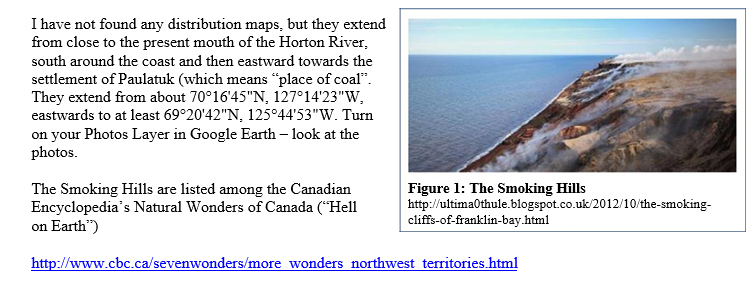
d) What causes the smoke?
e) Find all the areas of badlands around the Horton River. These are gullies cut into soft Cretaceous rocks (extremely dissected, very little vegetation, e.g., similar landscape to that at 69°37'37"N, 126°49'43"W). On the saved image (see next task) outline the areas of badlands and add a label. It would look nice if you use a semi-transparent fill.
f) Save an image of the region from an altitude of about 200 km (Figure 2). Annotate the image to show the Horton River Mouth (this will already have the Google placemark that you are putting on every site), the region of badlands (outline the main section) and outline the main region of the Smoking Hills. (Remember that all the annotations have to be done outside of Google Earth – each image will have only one Google placemark).
Put Figure 2 (and caption) here
FYI: According to one of the river canoeing guides “Because of the sulphur burn-off, the few lakes in this vicinity are among the most acidic in North America and they are almost completely devoid of any life” Downloadable file at spectacularnwt.com/sites/default/files/hortriver_1_0_0.pdf (note spelling mistake … Mesozoic).
2. MT. ASSINIBOINE
Glacial features of BC (Turn on the Borders and Labels layer in Google Earth. You sometimes have to zoom in to find out the name). Find Mt Assiniboine (50°52'10"N, 115°39'03"W)
a) Knowing where this is in relation to the geological provinces of Canada, and by looking at the features on Google Earth from an elevation of about 1 km, what can you tell about the geology and the nature of the rocks?
FYI: There is a lot of useful detail on the geocaching website https://www.geocaching.com/geocache/GC5HB9H_mount-assiniboine-earthcache?guid=7b522f77-3122-48c9-8f3b-73d6382f8821
b) View the mountain from about 25 km altitude. The elevation of the point under your mouse is given at the bottom of the Google Earth screen.
What height is Mt. Assiniboine?
c) What is the elevation difference between Marvel Lake (50°52'31"N, 115°33'43"W) and the top of Mt. Assiniboine?
Mt Assiniboine is a pyramidal peak, Marvel Lake is a Finger Lake occupying a glacial U-shaped valley. At the head of the glacial valley is a cirque.
Turn the image so that west is facing up. Use the oblique view feature to look from Marvel Lake straight up the valley at Mt Assiniboine (i.e., so that Mt Assiniboine is at the top of the image). Get it so that the view is not too low to the ground, so that it looks like a nice landscape.
d) Save the image (Figure 3). Annotate the image with labels for Mt Assiniboine, and the cirque at the head of the Marvel Lake valley (and mark its headwall with a curved line).
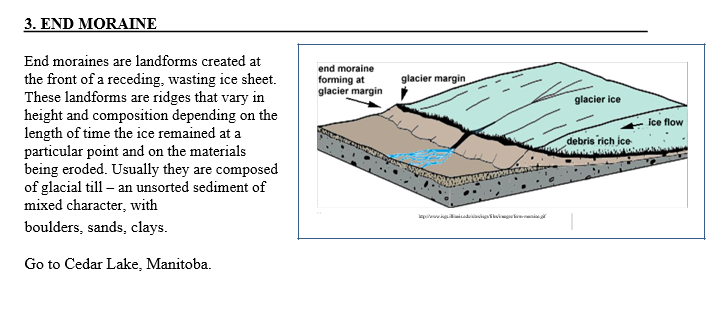
View from about 200 km altitude. Running all along the southern shore from west to east is a wide ridge of material deposited at the edge of the Laurentide ice sheet as the terminus remained stationary for some time. Manitoba Hwy #60 follows this feature (it is an End Moraine), which extends out into Lake Winnipeg forming Long Point.
a) Save the image (Figure 4). Outline (i.e., a line that marks the edges all the way around the whole feature) the end moraine and label it on the image.
4. GLACIAL GROOVES
Manitoba Interlake area. Go to 52.3 N, -99.3 W. This is part of the Interlake area of Manitoba.
a) Give the names of the two big lakes that you can see from an altitude of about 600 km. Zoom in to about 100 km altitude.
Most of this area was scoured by glacial erosion. Long, linear grooves were carved out by the ice into the Devonian bedrock, the ice exploiting minor variations in resistance to erosion. This can be seen in the pattern of bare ground and forest cover.
b) What was the main direction of ice movement? (you will have to think about the regional context – where was the main body of ice likely to be?)
c) Is the forest on the higher ground or the lower ground? (Zoom in to look at the distribution of the small lakes and then see how it relates to the growth of trees).
5. KLINAKLINI GLACIER
Go to 51.4 N, -125.8 W.
The Klinaklini Glacier, to the southeast of the Ha-Iltzuk Icefield located in the southern Coast Mountains of British Columbia, results from the coalescence of three smaller glaciers. The terminus of the glacier is now marked by a moraine-dammed lake, from which drains the Klinaklini River. Downstream from the terminus the valley is full of unsorted glacial debris deposited from melting ice as well as debris sorted by running water, the whole deposit forming the Outwash Plain.
a) Zoom to about 34 km altitude, with the glacier at the top and all of the snout visible, and save the image (Figure 6). Mark on your image (with label and outline, - i.e., a wavy line that marks the edges all around the feature – not a circle or ellipse) the Moraine-dammed Lake at the snout and the Outwash Plain (or “Valley Train”) that continues down the valley .
A “Valley Train” is fluvioglacial deposits, of braided stream deposits from glacial meltwater, filling a valley floor. A nice example can be seen on Bylot Island in the Canadian arctic, at 73°11'54.75"N, 79°48'37.74"W (viewed from about 25 km, you can see the glacier, the valley train and the delta to the west). In this same image, at 73°12'8.55"N, 79°44'59.23"W, is a small moraine-dammed lake.
A “trim line” shows the height to which the last glacial (re-)advance reached: those parts of the landscape that have recently been under ice have not yet been re-colonized by trees. Zoom in to find the most recent trim line of the Klinaklini Glacier; eg, 51°22'31.68"N, 125°47'22.84"W. Follow this north and south. This is most likely to represent the ice edge during the Little Ice Age. (During the Last Glacial period the valley was full to the brim with ice).
b) On your saved image, mark the Little Ice Age Trim Line to either side of the main ice flow (obviously only the bits you can see well) with lines and a label.
6. LIVINGSTONE LAKE DRUMLIN FIELD
Go to 58.73 N. -107.25 W. View it from about 10 km at first.
You’ve probably heard of the Peterborough drumlin field … but Canada has several other quite remarkable drumlins and they have spawned several interesting theories of drumlin formation.
“Since 1983, several investigators have developed a theory of drumlin formation by catastrophic flooding due to the release of meltwater that is believed to have accumulated beneath melting ice sheets. The proposed catastrophic sheet floods, as wide as the drumlin fields, formed the drumlins and related streamlined landforms, such as flutings, over wide areas
… The Livingstone Lake drumlin field in Saskatchewan, where some very striking examples of streamlining occur, was the type region for the development of the new theory“ http://www.sentex.net/~tcc/sgfcrit.html
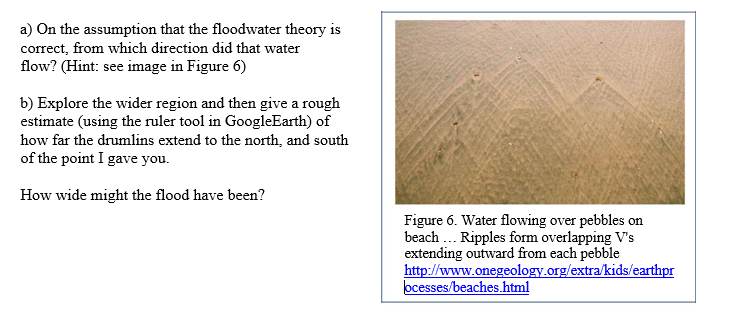
7. CAMPBELL RIVER, NEAR INUVIK, NORTHWEST TERRITORIES
68° 8'21.19"N 133°46'39.01"W
The river that connects Campbell Lake and the Mackenzie River has the remarkable property of reversing flow. Sometimes the water from Campbell Lake drains out normally into the large Mackenzie River. However, sometime, the water from the Mackenzie River flows some distance up the smaller Campbell River!
a) Viewing from about 4 km, compare the size of the main Mackenzie River channel and the Campbell River channel (measure each channel three times and give the average – in metres).
b) The imagery you get is from November 2012. Using the Historical Imagery tool (from about 5 km altitude) click on June 2004. Save this image. Then click on July 2002. Save this new image. Now place them side by side as Figure 7a (June 2004) and b (July 2002). (You will need to group them to keep them side by side)
What is the obvious difference between the two? Which direction is the water flowing in each image? How can you tell? Indicate these answers by adding arrows to show flow direction for each river, and the names of the rivers to Figure 7 and in your caption. (In WORD, insert shapes , choose one of the arrows, turn it around to the correct orientation. Then you must Group it with the image and Wrap Text to square)
Put Figure 7a and b (and caption) here
c) What might control the relative water levels of both rivers?
d) Go back to the most recent imagery. Zoom out to about 30 km, so that you can see both the area of paler, rock outcrop (these are the Campbell Dolomite Uplands) about 1 km to the north-east of your place mark and the area of flood plain (this is the Mackenzie River) about 1 km to the west. This region is all periglacial (ground temperatures below 0°C), but the effect on the landscape varies with the material – rock of alluvial sediment and peat.
Describe the differences you can see in the landscape between the Mackenzie River Flood plain and the Campbell Dolomite uplands (e.g., how high are the uplands above the plain?, what is the nature of the edge of the uplands? How are the lakes different in the flood plain compared to the bedrock uplands?)
e) Compare two of the lakes in the flood plain using the 2004 imagery – Lake A: 68° 7'53.81"N 133°53'3.07"W with Lake B: 68° 9'8.42"N 133°50'11.57"W. One of them gets input from the Mackenzie River while the other does not. Which has direct connection with the river? What effect does this have on the water?
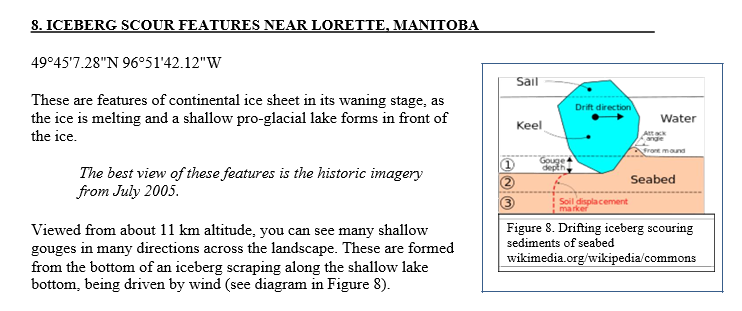
a) For ~10 of these scour marks around the placemark, measure the azimuth (using the ruler/measure distance tool – it shows “Heading” as well as distance). Record the ten measures (here).
What is the dominant direction (azimuth)?
Can you tell which direction the wind came from? (obviously with a simple linear feature you cannot know for sure which direction it came from … but think about a big cold ice-sheet centred over the Canadian Shield, with cold descending air blowing out from the centre of the ice-sheet. That should give you a clue about which way to place the wind arrow.)
Save the image as Figure 9. Add an arrow to show the dominant wind direction (grouped with the image and caption).
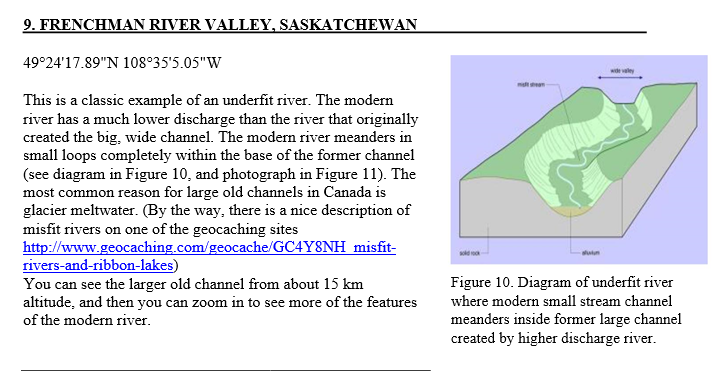
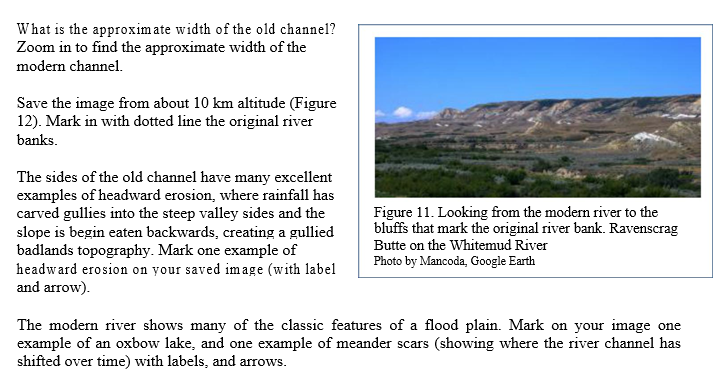
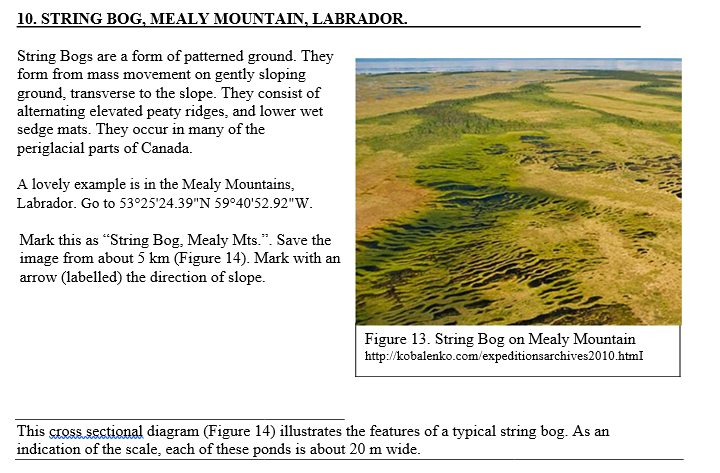
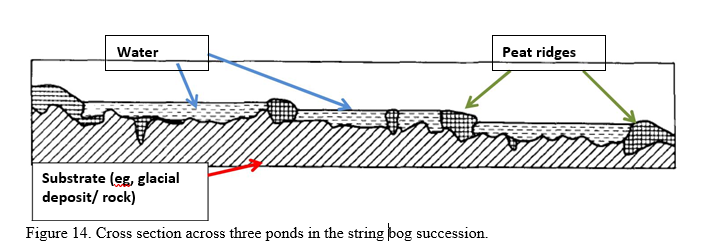
Using the Ruler tool on ten or so examples in one area (so choose all of the bogs next to each other in one area), list the ten distances.
Average them to estimate the typical distance across the sedge bogs from ridge to ridge.
Estimate the slope angle from 53°25'17.41"N 59°41'37.25"W to 53°25'19.44"N 59°40'13.78"W. For this you will need the distance and the drop in elevation in the same units … slope is rise over run.
You can use a simple on-line calculator such as
http://www.1728.org/gradient.htm
OR
http://www.calculator.net/slope-
calculator.html?type=1&x11=0&y11=0&x12=1525&y12=12&x=58&y=13
Please quote your answer as Degrees and as % Grade.
Another example can be found in northern Manitoba. Go to 54.459924 -98.975624. Mark this with a Google placemark labelled “String Bog, Manitoba”.
How does the example from Mealy Mountain compare with the example from Manitoba? Compare the width of the sedge bogs for both.
Compare the slope for both
11. FINAL MAP OF CANADA
The last figure is the whole of Canada with all the placenames showing (but remove extraneous labels, etc. so that the image is clean. You will have to make the font bigger in all the placemarks in order to be able to read them on this figure.). That will allow you to see where all the features are relative to each other.
A few helpful instructions.
Significant figures: Don’t offer ridiculously precise figures which suggest that you measured to within 1 centimetre.
Quality of annotations: they need to look reasonably professional … eg, you can add nice arrows and lines simply using Word. You don’t need to scribble lines.
Google Earth is available on the lab computers, or can be downloaded for free to any computer.
Images are exported from Google Earth by selecting [Copy Image] from the [Edit] menu. This will export your current view so make sure that everything looks just the way you want it before you copy the image.
Any annotations you need for your images should be added after pasting the images into a basic editor such as Paint or Word or Microsoft Powerpoint, available on the lab computers.
To prepare your document for submission, simply compile your completed images and assignment text into a Microsoft Word document (also available in the computer labs). Once your document is complete and exactly the way you want it, publish it as a PDF. To do this, simply select [Save As] from the [File] menu – choose pdf. If your file is huge, you may need to Print as pdf rather than Save as pdf.
Make sure that all images have a meaningful caption.